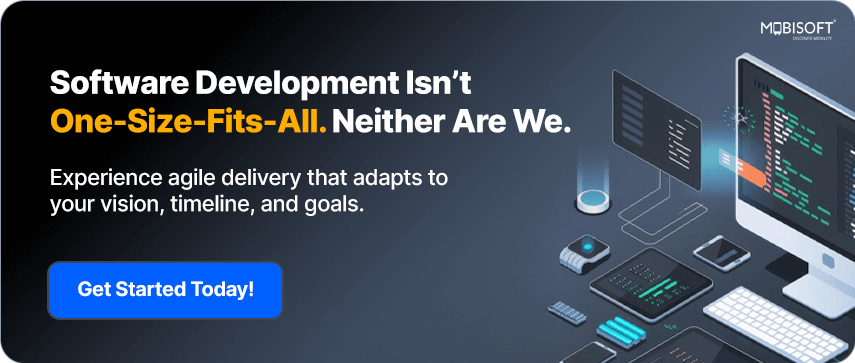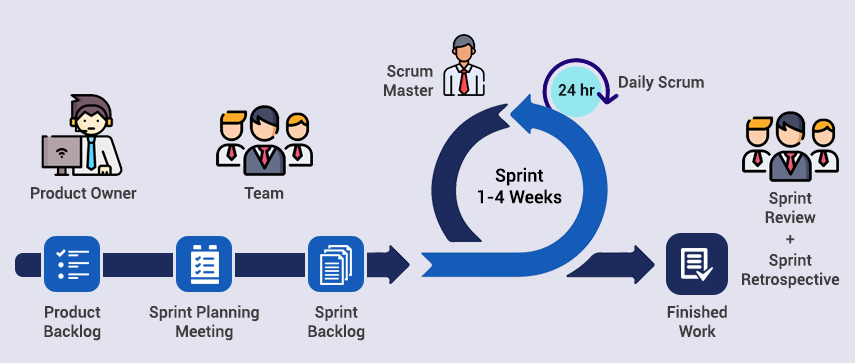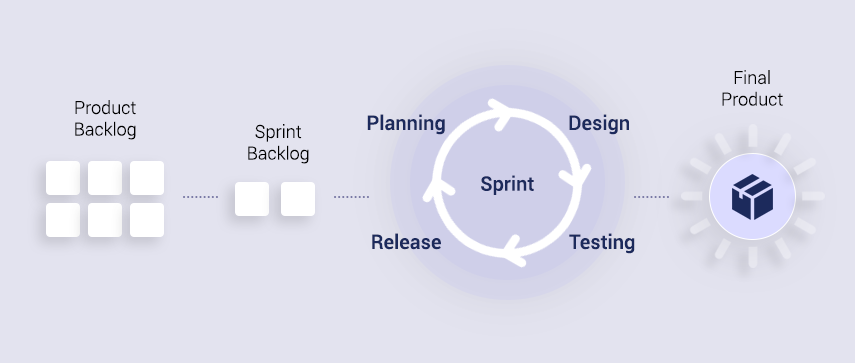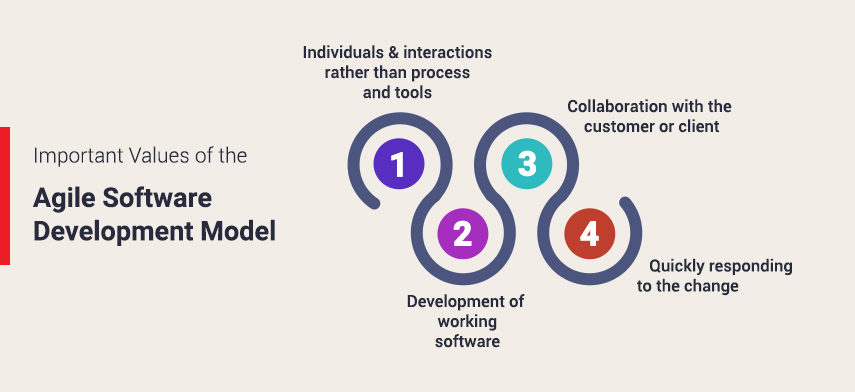With a tremendous change in mobile technology, smartphones and mobile apps are ruling our lives. Calling is not the sole purpose of mobiles anymore. Every small and large business is going mobile by leveraging the benefits of video calling apps, messengers, social media apps and cloud-based apps.
It is essential to regularly update the mobile apps to fit in the changing needs of the users and the businesses today. Innovation is a must to keep up with the recent trends of the markets and sustain the competitive edge. However, being a complex task, mobile application development requires integration of a range of features to make it a success.
Agile software development is recognized worldwide as an excellent framework for mobile app development. We aim to guide the technology and non-technology professionals into the agile world through this post. The guide will help developers and testers understand the agile SCRUM methodology for software development and testing.
The guide will take you through the agile journey in a step-by-step manner to help you understand the principle underlying agile and its need in the software development industry. Learn about the advantages and challenges of Agile methodology and how to apply agile and scrum learning to work.
Introduction to Agile
Agile is a software development framework and a technology that is widely used across the globe for mobile app development. The birth of agile software development was to overcome the drawbacks of the cumbersome waterfall techniques.
The existing waterfall techniques failed to provide feedback for the product until it was finally ready to be delivered. Unlike waterfall,
Agile is an incredible solution to the demerits of existing techniques as it gives the developer a scope for constant feedback from the end user. It is highly beneficial for the organization because the cost of rework is too high and agile development eliminates such a waste of time, money and efforts.

What Exactly is Agile Software Development?
Agile software development is a set of rules that allow continuous iteration of development and testing of the product for making continuous deliveries. The agile application promotes adaptability, flexibility and encourages communication due to which a team can work with greater efficiency and improve throughout the process.
Agile development methodology is not only easy to apply but also caters to all the needs of the software development industry. It is easy because of the methodology that divides a complex task into a series of small tasks for the development team. Each team member can work on the respective task as per their expertise. Unlike the large projects, the small projects decrease the development time.
Agile does not have a set of rules or processes and tools. It does not follow a plan or have comprehensive documentation. Instead, agile comprises of interactions between developers, customer collaborations, negotiations and natural responses to change.
Why is Agile Methodology Used for Mobile App Development ?
Mobile app development is quite a complex task where the customer's demands keep changing from time to time. The complexity is due to the difference in software, hardware, and different networks. Further, there are diverse ways a user interacts with smartphones. Hence, there is a need for an iterative and flexible approach to come up with effective planning, involve customers, consider their needs, for regular evaluation, and risk management. This is possible by implementing the agile methodology – an approach useful for a complex process where the customer’s requirements change from time to time.
The agile testing methodology comprises of various methods including:
- SCRUM, crystal methodologies
- DSDM (Dynamic Software Development Method)
- Feature driven development (FDD)
- Lean software development
- Extreme Programming (XP)
All the above methodologies focus on lean software development and help the developers work efficiently and effectively. These methods help apply agile into action and open scope for process improvement. However, this post primarily deals with the agile SCRUM methodology in mobile app development.
What is SCRUM?

SCRUM methodology is initiated by the SCRUM master whose role is to set up a team, sprint meetings and remove any obstacles to the progress of the project. The next step is the product owner creating the product backlog, prioritizing and responsibly delivering the functionality at each iteration. Lastly, the SCRUM team manages and organizes its work to complete the cycle (Refer SCRUM development cycle).
The methodology is effective in monitoring the progress of the project and detecting any errors based on the knowledge gained from past mistakes when it was difficult to define the requirements of the project.
In short, when the project is in progress, SCRUM allows to check and resolve any difficulties as soon as they are identified. Hence, one can take immediate corrective action while discussing over frequent meetings. The benefit of the SCRUM methodology is to take action as per the change in the requirement.
We have learned about the basic manifesto of agile software development and have discussed the difference between the agile and its superiority over traditional waterfall methods.
Agile Development Cycle
Agile development cycle starts with the agile process flow that involves:
- Developing concept: envisioning and prioritizing the product
- Inception: identifying the team members, funding and discussing the initial requirements and environments
- Iteration/construction: developers develop working software as per the feedback and iteration requirements
- Release: an iteration is released into production after quality testing and proper documentation
- Production: ongoing support of the software
- Retirement: end of software development along with customer notification and migration
Now let us understand the SCRUM lifecycle for agile software development. It includes the following steps:

- Product backlog: documentation based on the end user’s perspectives and opinions is created by the product owner. The complex requirement is then broken into simpler tasks.
- Sprint backlog: tasks are prioritized and divided into sprints, where each sprint will contain a set of tasks through sprint planning. The SCRUM team then creates a document called sprint backlog.
- Execution phase: this is the cycle of several iterations, where each iteration comprises of discussion, planning, decision, development and testing activities. Meetings in this phase are executed by SCRUM master and work on eliminating any obstacles to the process.
- Sprint review: retrospective and introspective analysis of sprint for better planning for next sprints. After review, the iteration one is carried out and evaluated for the acceptance.
- Increment: the team will demonstrate the increment 1 of the development carried out. The customer feedback is then used for all the sprints in the future.
- Final product: the SCRUM cycle continues as per the five steps mentioned above and the team releases the final product after completing all the sprints.
Agile-SCRUM Challenges, Development, and Best Practices
We have also discussed why is the agile methodology used for mobile app development and the insights of SCRUM methodology. In this section, we will get to know about the agile challenges, development and best practices as well as the advantages of agile development methodology.
Agile methodology is not as simple as it appears and its implementation does involve challenges. If you are trying to follow the basic rules and practices to get started then the chances are high that the real-life challenges will kick you hard.
- Training and skills required
- Resistance to change
- Everyone may not be on the same page
- Handling bugs and urgent on-demand tasks
- Integration with project/Project management
- Scalability issue
Want to know how to overcome these challenges? Read on the agile-SCRUM best practices that focus on outcome instead of the output.
- Create the product vision & Product Backlog together
The best practice is to provide the customer with a good idea of the product backlog. It is often seen that the customer has a good vision of the product but not of the product backlog. It is suggested to create the Product Backlog together by organizing a workshop with the customer and the supplier’s Development Team. It will ensure good understanding between the customer and the supplier. This practice is vital to establish the customer’s trust in the development team that will fulfill their requirements.
- Form an impression of the implementation effort of the Product Backlog together
Creating and estimating the Product Backlog together in front of the customer is advantageous. The customer can listen to the entire discussion and address any query. This practice helps in easy detection of any complexities and reach a mutual understanding about the given estimations.
- Find out the business value of the Product Backlog together
It is effective to determine the product backlog during the implementation planning together with the business value. Discussing and determining the business value will help the stakeholders to understand the priorities and define what is more valuable. Simultaneously, the development team can determine the implementation efforts and proceed with the one offering greater value. The benefit of this practice is that the product owner is not the one entirely responsible!
- Invite the customers to SCRUM events
Customers should be given the opportunity to know how SCRUM works. Participating in the SCRUM events will allow the customer to experience the discussions during the Sprint Planning. It gives them the opportunity to give feedback and share lessons learned during the sprint review. Feedback about the delivered product and evaluation of the collaboration is very important for the improved quality of the product.
- No wasting on daily meetings
Detailed discussions during meetings may be a big waste of time and it is advised not to extend beyond 15 minutes. Listening to other member's problems in details may hamper the progress of the project. It can be later discussed in details with the SCRUM master by involving only required members from the team.
- Sell the entire SCRUM team
A fixed SCRUM team with experienced members is worth a gold!!! The members know their velocity as they are working for a very long period and knows the nitty-gritty of handling different types of project. Separating them when new project arrives is not a good deal. Let the team of analyst, tester, designer, developer SCRUM master, and others be together. Divide and rule is a great pitfall here!
- Sell sprints
It is important to know the velocity of your fixed teams to sell the sprints for this team easily. The benefit of working with the experienced team is to estimate the product backlog well and how much sprints will it take say 5-7 sprints. Now, it is easy to estimate the budget of the project by knowing the cost per sprint. The SCRUM team can then decide on the cost of continuing the project and if it is profitable for buying any more sprints.
Advantages of Agile/SCRUM Methodology
The new developers usually wonder about the advantages of the agile/SCRUM methodology. Some of the important advantages of this approach are listed below that will be useful for you in gaining deeper insights into agile software development.
- Creativity
An average running mobile app is a big no in today’s highly competitive environment. Creativity and innovation is the must for making product excellence and efficiency. Agile/SCRUM methodology values creativity for developing a solution that in turns boosts business value.
- Flexibility
To come up with a flawless mobile app that meets every need of the business or the user, flexibility is the word. Working in an uncertain environment demands to define the requirements and detailing designs for the solution before starting the project. An agile/Scrum approach works wonderfully when working in such an environment and ensures flexibility/adaptability to meet the demands of a project in progress.
- Improved quality
Agile methodology ensures the quality of the product, which is the core responsibility of the mobile app developers. Quality is an integral part of the development process when using agile/SCRUM methodology.
- Client satisfaction
The Agile software development approach ensures high customer satisfaction because he or she is an active participant in the feedback process. A customer is allowed to give the inputs throughout the development process, which helps developers come up with more effective solutions.
- Developer satisfaction
Agile/SCRUM methodology also ensures satisfaction of mobile app developers working as a team, where each member is engaged in improving the quality of the product as well as taking the responsibility of their respective roles.
- Cost-effective
Agile methodology decreases the cost of the product by reducing unnecessary documentation and control requirements. This boosts the team productivity by prioritizing the project requirements so that the value of the features do not exceed the cost of development.
- Time-to-market
Agile/SCRUM ensures shorter startup times, which results in faster time-to-market due to incremental development efforts. The best part is one does not need to wait for 100% completion of the entire product.
Wrapping Up,
These are the most important aspects you should know about Agile software development and SCRUM methodology. Hopefully, this guide will help you and your team in transition to an agile methodology. Keeping in mind the principles, roles, and processes will aid in the change of your mindset. The team can be more flexible and adaptive to changes. As per pioneers in the software development industry, agile m
Apply agile methodology and reap its benefits, and remember to implement intelligently in the right situation. It is not a magic bullet so do not take it for granted or think of it as a solution to every problem! The widespread adoption of agile methodologies is yet to be achieved, which demands the testers to sharpen automation skills and deeply analyze the software development process. Holistic testing strategies are a must for greater maturity of the agile methodologies.
Liked this post?
Subscribe to our newsletter and get the latest posts right to your inbox.





 February 21, 2019
February 21, 2019


